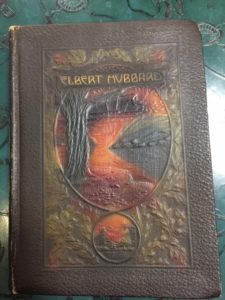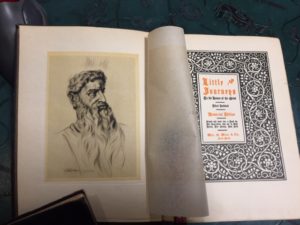 PL owns a series of nine books, Little Journeys to the Homes of the Great, dating from 1916 to 1925 by the author Elbert Green Hubbard (1856-1915). If you know the history of the Craftsman era, you know why great people desire great homes. Here’s the crux of Elbert’s books, also the purpose of this article:
PL owns a series of nine books, Little Journeys to the Homes of the Great, dating from 1916 to 1925 by the author Elbert Green Hubbard (1856-1915). If you know the history of the Craftsman era, you know why great people desire great homes. Here’s the crux of Elbert’s books, also the purpose of this article: - Certain markets for selling books are death.
- Certain markets are great, if you are selling something ‘niche,’ like this series about HOMES.
If you live in Santa Barbara in a California Bungalow or a Mission Style home or a Craftsman Cottage, Elbert Hubbard popularized your style of living. He founded the Roycroft Artisan Community in East Aurora NY.
Handsome, dark, charismatic, he led a turn-of-the-last century “romantic” life: starting as a door-to-door soap salesman. Elbert ended up wealthy (and we shall see ‘pursued’) enough to book a passage on the RMS Lusitania. When the boat was torpedoed in the Atlantic 11 miles outside of Ireland, some say causing US involvement in WWI, Elbert perished with a certain woman. They died in an embrace together.
Elbert kept interesting friends and hardworking women around him. He married Bertha, who helped establish his Utopian Dream, The Roycrofters. She also functioned as quite a fine bookbinder and businesswoman. Elbert left her for his mistress with whom he fathered a love child. Alice was also a great early 20th century “romantic,” a Suffragette, an able manager of the Roycrofter Inn and Roycroft School for Boys, and an all-around social idealist. Turns out, she traveled with Elbert on the Lusitania as a newspaper correspondent for WWI, on her way to Germany to interview Kaiser Wilhelm II. Wondering if she could have changed the Kaiser’s mind, she drowned with Elbert in 1915. You may note that the last volume was published in 1926. Bertha published that! After the drowning of Roycrofter’s founder, his first wife Bertha reappeared and took over the Upstate New York Utopian community for years. Divine vengeance.
What is written in PL’s Hubbard Series is a fascinating glimpse into early 20th century freethinking life. The books you read, the house you keep, the land you live with, and the objects in your home, Hubbard says, should reflect your moral integrity. You can see the direction he is going in the Volume called Homes of the Great Teachers. Here’s a list of the homes he describes (although HOW he knew what they looked like is a mystery): Moses, Confucius, Pythagoras, Plato, Erasmus, Booker T Washington and St Benedict, ending with Mary Baker Eddy. These great people, see, had great homes, reflecting real character! And your character, he preachifies, should be built on certain things. According to Hubbard your individuality, your freedom, your love of your native land, your care of handmade objects, yet all these things reflect an underlying social anarchy.
Hubbard attempted to blend his type of Utopian artist-based socialism with American Exceptionalism. Roycrofters in NY was such an example, forming a bookbindery, leather shops, copper shops, furniture-making studios in the early 20th century. The community failed due to arguments in 1936. Things marked Roycroft are valuable today.
 He believed that the products of his hands, and of his colleagues, which he sold at a good profit, reflected a certain kind of place. A place where equality prevails, what you need is provided, and therefore there’s no competition. That’s why the covers of PL’s nine volumes are all embossed red on green drawings of a NY stream, meandering. This is noncompetitive philosophy from a former door-to-door soap salesman, who developed for the world the concept of leaving the soap at the house and clients’ only paying for it if they liked it. Nothing like a convert, so they say.
He believed that the products of his hands, and of his colleagues, which he sold at a good profit, reflected a certain kind of place. A place where equality prevails, what you need is provided, and therefore there’s no competition. That’s why the covers of PL’s nine volumes are all embossed red on green drawings of a NY stream, meandering. This is noncompetitive philosophy from a former door-to-door soap salesman, who developed for the world the concept of leaving the soap at the house and clients’ only paying for it if they liked it. Nothing like a convert, so they say.
And why, you ask, did he want to leave for an extended time on the eve of WWI to Europe on the doomed ocean liner? A conviction against him for breaking US Postal Laws, which said you couldn’t mail anything salacious.
Therefore, PL, sell these books at a Craftsman Convention, on a Arts and Crafts Website, to a collector’s market that holds these ‘truths’ dear. Do not sell them on the open market, where you will get about $150 for 9 volumes, if you are lucky. And these are hand bound, and hand sewn, and lovingly illustrated. Too cheap, but the thoughts they contain are too moralistic for 2019. The books are art.